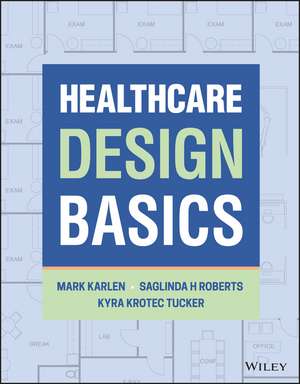Healthcare Design Basics
Autor M Karlenen Limba Engleză Paperback – 4 iun 2023
Preț: 347.66 lei
Preț vechi: 489.49 lei
-29% Nou
66.53€ • 69.63$ • 55.37£
Carte indisponibilă temporar
Specificații
ISBN-10: 1119813670
Pagini: 208
Dimensiuni: 217 x 274 x 11 mm
Greutate: 0.63 kg
Editura: Wiley
Locul publicării:Hoboken, United States
Notă biografică
Mark Karlen (1929-2022) was an architect, educator, and author with extensive experience working in and teaching in the field of interior architecture. His other titles include Lighting Design Basics, Space Planning Basics, and Sustainable Design Basics. Saglinda H Roberts is an Assistant Professor in the Interior Architecture program at Chatham University and has over 30 years of extensive experience in a broad range of project typologies. Her focused research is on the holistic analysis and integration of stakeholder needs. Kyra K Tucker is Chair of the Interior Architecture & Immersive Media programs at Chatham University and the principal of Kyra Tucker + Associates Interior Design. She has over sixteen years' experience working in commercial and healthcare design.
Cuprins
About the Authors ix Acknowledgements xi Chapter 1 Introduction 1 Organization 2 Design Exercises 2 Additional Resources 2 Getting the Most Out of This Book 3 Companion Website 3 Additional Resources 3 Chapter 2 Evidence-based Design 5 What Is Evidence-based Design (EBD) 5 Origins of Evidence-based Design - A Brief History 5 Importance to Design 6 Principles and Process 7 Attributes of Evidence-based Designers 8 Associated Organizations 9 Additional Resources 9 Chapter 3 General Elements of Healthcare 11 History of the US Medical System 11 Codes, Regulations and Industry Standards 12 Specialized Facility and Mechanical Requirements 12 Specialized Demands on Healthcare Workers 18 The Built Environment's Role 18 Additional Resources 19 Chapter 4 Holistic Analysis 21 Stakeholders 21 Operating Standards, Codes, Profitability + Administrator's Perspectives 22 Holistic Analysis 22 Holistic Analysis of the Typology and Its Stakeholders 23 Case or Precedent Studies 24 Interviewing and Observation 25 Integrative Design 26 Summary 27 Additional Resources 27 Chapter 5 Room Requirements 29 Prototypical Space Requirements for Areas Found in Most Healthcare Facilities 29 Technology 51 Resilience 51 Additional Resources 52 Chapter 6 Major Specialties 53 Pediatrics 53 Dentistry 55 Gerontology 59 Palliative Care 61 Psychological + Psychiatric Practice 61 Orthopedic Offices 63 Internal Medicine 65 Alternative + Naturopathic Medicine 66 Additional Resources 68 Chapter 7 Group Practices 71 Single Specialty Group Practices 71 Multiple Specialty Group Practices 71 Employed Physician Practices 72 General Considerations 72 Typical Shared Functions and Components 74 Additional Resources 77 Chapter 8 Clinic Practices 79 Community Health or Care Clinics 80 Urgent Care Facilities 82 Facility Specific Treatment Spaces 84 Additional Resources 85 Chapter 9 Specialized Ambulatory Centers 87 Ambulatory Surgery 88 Physical Therapy 91 Cancer Treatment Centers 93 Dialysis or Kidney Treatment Centers 96 Additional Resources 98 Chapter 10 Architectural Considerations 101 Sustainability 101 Structural Systems 103 Shell or Exterior Envelope 104 Mechanical Equipment + Technology 105 Interior Construction 106 Materials 111 Medical Equipment + Technology 111 Adaption + Resilience 112 Codes 113 Additional Resources 113 Chapter 11 Lighting 115 Review of Basic Lighting Principles 115 Natural Light 116 Artificial Light 119 Occupant Concerns 119 Additional Resources 123 Chapter 12 Interior Finishes + Furniture 125 Healthcare-Specific Considerations 125 Interior Finishes 127 Furniture 129 Additional Resources 131 Chapter 13 Biophilia 133 What It Is....and What It's Not 133 Why Biophilia Is Important 134 Integrating Biophilic Elements 138 Attributes + Elements of Biophila 138 Application in Healthcare Facilities 141 Additional Resources 141 References 142 Chapter 14 Health + Well-Being 143 What Is Well-Being + Why Is It Important 143 Implications for Medical Facilities 143 Elements + Strategies in Healthcare Settings 144 Rating Systems that Address Well-Being 148 Foundations of a Healthy Building 149 Long-term Implications 150 Additional Resources 150 Appendix I Base Plans 153 Appendix II Assignments and Exercises 161 Glossary 173 Index 181
Descriere
HEALTHCARE DESIGN BASICS An approachable and robust treatment of designing and planning spaces for use in healthcare settings In Healthcare Design Basics, a team of distinguished interior architecture practitioners and educators delivers an up-to-date text covering the critical aspects of healthcare design, preparing students for a specialty rapidly growing in importance and size.
The book adopts an approach designed to crystalize the most important elements of broad range of ambulatory facilities for healthcare design students and new professionals in a clear, concise, and approachable way. The authors combine a broad overview of numerous ambulatory healthcare typologies with exercises that allow students to prepare detailed plans for many of the most commonly used rooms and typologies in the healthcare industry, thus preparing them for the demands of professional positions.
The book also includes:
* Step by step studio guidance outlining the basic design elements required for a wide range of ambulatory healthcare facilities and rooms
* Comprehensive explorations of the demands of new and improved healthcare facilities that meet the needs of an aging population
* Practical discussions of the space planning challenges involved in designing rooms and facilities for use during public health crises, including pandemics
* Dozens of full-color images that illustrate and highlight important concepts, examples, and design solutions Written for students of interior design, architecture, and emerging professionals, Healthcare Design Basics also benefits professionals tasked with the initial planning and design of ambulatory facilities, and other healthcare settings.
